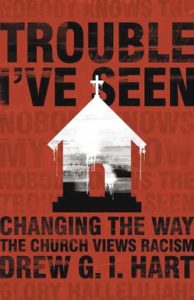Trouble I’ve Seen: Changing the Way the Church Views Racism
Reviewed by Steve Chase
January 1, 2018
 By Drew G. I. Hart. Herald Press, 2016. 157 pages. $29.99/hardcover; $16.99/paperback; $12.99/eBook.
By Drew G. I. Hart. Herald Press, 2016. 157 pages. $29.99/hardcover; $16.99/paperback; $12.99/eBook.
A few months ago, I walked to the Festival Center in Washington, D.C., to hear a talk by a young Anabaptist theologian and blogger named Drew Hart. His topic was resisting racism, and his message was delivered with deep wisdom, passion, anger, and love. On my way out, I picked up a copy of Hart’s book Trouble I’ve Seen: Changing the Way the Church Views Racism, and I vowed to write a review of it for Friends Journal.
Hart calls all of us in the wider church to become more faithful friends and followers of Jesus in order to address racism. This might sound off topic or naive, but in his book, Hart speaks from the radical black liberation theology tradition and challenges us to see Jesus with new eyes. To start, he urges modern Christians to free themselves from the idol worship of the power-holder’s well-crafted white/apolitical/blond/sweet baby/Jesus/god-man holding out tickets to an otherworldly heaven that leaves so many believers conformed and complicit with an oppressive status quo.
Hart’s big request is for us to refocus on the brown-skinned, nonviolent revolutionary, Palestinian peasant in scripture who—inspired by the Jewish prophets of old—was directly in touch with the Divine and openly challenged the “powers and principalities” of his day. These included the occupying Roman empire, its client kings, and the collaborationist religious elite in Jerusalem. He reminds us that Jesus preached and practiced a radical gospel of love, justice, simplicity, solidarity, and compassion “from below” among “the least of these”—the powerless, the outcast, the poor, the oppressed, the imprisoned, the exploited, and the marginalized. Jesus urged his followers to repent and refuse to conform to the oppressive ways of domination, so rampant in our world. He asked instead for them to foster a beloved community shaped by the way and wisdom of a just and compassionate God.
Without this revolution in our faith commitments, Hart says most Christians will continue to “operate out of a naive and thin understanding of racism, which doesn’t factor in the depth and width of our racialized and hierarchical society.” To make his point, Hart opens the book with a personal story about sitting in a McDonald’s having sweet tea with a white clergy member he had recently met. During the conversation, the minister shared with Hart how important their conversation was to him. He said there is no other way to racial reconciliation except engaging in this kind of dialogue across the racial divide. The minister then pointed to a paper cup of tea on the table between them and said we can’t know about the whole cup unless you describe your side of the cup to me and I describe my side of the cup to you.
As Hart tells the story, he appreciated the minister’s good intentions and his wanting racial healing in the church and the wider world. At the same time, Hart felt that the minister, like most white Christians, misunderstood the problem of racism “as though it were a horizontal divide between two people of equal standing,” who just need to understand each other’s “cultural differences and quirks” and learn to be nicer to each other.
As a young black man in the United States, Hart believes that the crux of racism is not individual cultural ignorance or personal prejudice on either side of what W.E.B. DuBois called “the color line.” The bigger—and too often ignored—problem is white supremacy, a deeply institutionalized and evolving racial hierarchy built over centuries that still privileges white people at the expense of other racial groups of people. It is this racialized system of imperial hierarchy, among other imperial hierarchies, in which we all still live, move, and breathe, which advantages and over values some and disadvantages and devalues others, that must be made visible, resisted, and transformed by the faithful friends and followers of Jesus.
Hart’s experience, however, is that when the issue of racism is raised in this more radical way, many nice, well-intentioned, white Christians tend to check out and change the subject, to get fragile and defensive, to even complain about reverse racism, or decry how people of color manipulatively “play the race card.” They ask, “If I don’t hate people of color, speak ill of them, or act violently towards them, how can I be complicit with white supremacy?” This is sometimes followed by, “Hell, I marched for integration…and things are not as bad as so many black people seem to believe. We have made so much progress!”
Much of Hart’s book is a careful and powerful presentation of personal stories, research findings, historical analysis, and scriptural interpretation that encourages white Christians to see the world beyond this limited vantage point. Hart asks well-meaning white folks to grasp that because of their social location as witting or unwitting beneficiaries of this ongoing system, there is a “log in their eye” that makes it hard for them to believe black people’s experiences about the still existing reality of white supremacy in the church and the wider world. He has a whole chapter called “Don’t Go With Your Gut” about how white people have a long history of minimizing or denying the full reality of racism. Black people have usually been much more insightful of these dynamics because of their social location as the oppressed and marginalized. Facing this reality is the first step toward anti-racist work within the church and the wider world.
Going further, Hart ends the book by offering “seven Jesus-shaped practices for the anti-racist church.” These advices and queries are meant to help us “follow Jesus and courageously break allegiances with white supremacist, classed, and patriarchal hierarchies.” They are also to help us actively and effectively join “in solidarity with the stigmatized.” Like the rest of the book, this chapter is a prophetic challenge to most mainstream and evangelical Christians. I believe it is also a challenge to the United States’s small, liberal, predominately white, well-adjusted, middle class, Quaker community that routinely benefits from white supremacy and has lost much of its mooring in the spiritual path of a radical Jesus who seeks justice, love, and liberation.
Steve Chase is a member of the Putney (Vt.) Friends Meeting and currently serves as the Manager of Academic Initiatives at the International Center on Nonviolent Conflict in Washington, D.C. He is the author of the Pendle Hill pamphlets “Revelation and Revolution: Answering the Call to Radical Faithfulness” and “Boycott, Divestment, and Sanctions? A Quaker Zionist Rethinks Palestinian Rights.” He is also a regular contributor to “Minds of the Movement,” an ICNC blog on the people and power of civil resistance.



Comments on Friendsjournal.org may be used in the Forum of the print magazine and may be edited for length and clarity.